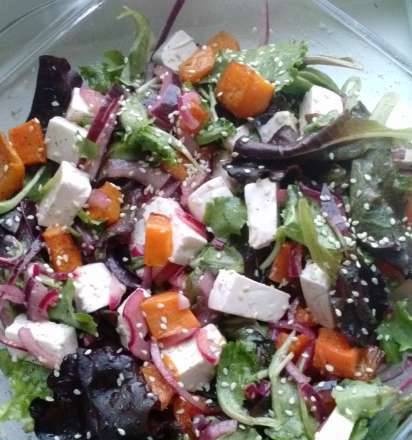I want to describe how I personally came to the idea of buying an oil press at home.
ForewordAt some point, I decided to take care of making my diet a little more useful for my beloved organism. There is an insane amount of information around, moreover, contradictory. After a little digging into the issue, I decided to rely primarily on those sources that are the most scientifically grounded at the moment. To get started with a little understanding of the reliability of scientific data and evidence-based medicine, I can recommend reading the article "Systematic review and meta-analysis. General information":
🔗As they say (and with which I generally agree), now very often the most reliable data can be found in
english wikipedia. It even happens that the data in it is more relevant than in specialized reference books. Of course, what is written in Wikipedia is not the ultimate truth, but usually it is closest to it. If a question really bothers you, then you can read the page on this in the English Wikipedia (you can also use an on-line translator, for example,
🔗 ), then the theses of the article usually have links to primary sources: these are the primary sources and need to be studied. They are often only available on a paid basis, but sometimes they can either be found or they are initially freely available for free.
During this time, I found the following, interesting, in my opinion, resources (given that we are more interested in fat consumption in this topic):
- Healthy Eating Fact Sheet # 394, WHO, September 2015:
🔗 - Nutritional Guides for Americans 2015-2020, United States Department of Health and Human Services (HHS):
🔗 - Fats and fatty acids in human nutrition, Food and Agriculture Organization of the United Nations (FAO), 2010, eng:
🔗 - Scientific Opinion on Dietary Reference Values for fats, including saturated fatty acids, polyunsaturated fatty acids, monounsaturated fatty acids, trans fatty acids, and cholesterol, European Food Safety Authority (EFSA) journal, 2010, English:
🔗
Actually, if someone wants to understand the issue on their own, then you need to read the documents I have cited: it explains what and why. In short, here are a couple of quotes:
This Opinion of the EFSA Panel on Dietetic Products, Nutrition, and Allergies (NDA) deals with the setting of Dietary Reference Values (DRVs) for fats. A lower bound of the reference intake range for total fat of 20 energy% (E%) and an upper bound of 35 E% are proposed. Fat intake in infants can gradually be reduced from 40 E% in the 6 12 month period to 35–40 E% in the 2nd and 3rd year of life. For specific fatty acids the following is proposed: saturated fatty acid (SFA) and trans fatty acid intake should be as low as possible; not to set any DRV for cis-monounsaturated fatty acids; not to formulate a DRV for the intake of total cis-polyunsaturated fatty acids (PUFA); not to set specific values for the n-3 / n-6 ratio; to set an Adequate Intake (AI) of 4 E% for linolenic acid; not to set any DRV for arachidonic acid; not to set an UL for total or any of the n 6 PUFA; to set an AI for alpha-linilenic acid (ALA) of 0.5 E% not to set an UL for ALA; to set an AI of 250 mg for eicosapentaenoic acid (EPA) plus docosahexaenoic acid (DHA) for adults; to set an AI of 100 mg DHA for infants (> 6 months) and young children <24 months; to increase by 100 200 mg preformed DHA in addition to the AI for adults as an adequate supply of n-3 long chain PUFA during pregnancy and lactation; not to set any DRV for conjugated linoleic acid. For cholesterol it was decided not to propose a reference value beside the limitation on the intake of SFA.

If very, very briefly and in your own words, it turns out that in a healthy diet, fat should account for 20% - 35% of all energy received from food, the consumption of trans fats should be reduced as much as possible, monounsaturated and polyunsaturated fats are preferable than saturated.
Minimum The consumption of polyunsaturated fats of the omega-3 (ω-3) class for alpha-linolenic acid is 0.5% of the total energy received, for long-chain polyunsaturated fatty acids ω-3, namely, eicosapentaenoic and docosahexaenoic fatty acids, a total of at least 250 g / day is required.
Considering that polyunsaturated fatty acids of the ω-3 class are not found in a very large number of products, in contrast to ω-6, mainly linoleic acid, and that acids ω-6 and ω-3 compete with each other, both for assimilation and inside a person (in this case, ω-6, usually "wins"), then in order to be able to assimilate and use ω-3, it is often necessary to control the intake of ω-6 fatty acids: linoleic. That is, if you do not change your diet, but simply add "benefits" to it, for example, in the form of food supplements containing alpha-linolenic, eicosapentaenoic and docosahexaenoic acids, then you may not get any real benefits if you do not change your diet in order to reduce the intake of linoleic acid (and there is some research on this).
I also want to note that it is important to consume both short-chain fatty acids ω-3: alpha-linolenic, and long-chain fatty acids eicosapentaenoic and docosahexaenoic, since one does not replace one another (see the links above for details). That is, if you drink flaxseed oil, this does not mean that you do not need to eat, for example, oily sea fish from cold waters (which, preferably, be at the beginning of the food chain), as well as vice versa.
Data received and what have I decided to change in my life? I decided to completely exclude sunflower oil, olive oil, despite the fact that it is a fairly good product, I have left first of all for frying (for those moments when better methods are not suitable for one reason or another: do not fry; fry , but do not add oil; fry in coconut or ghee), but simply use oils with a high content of alpha-linolenic acid in salads:
- Chia seed oil, 52%, source:
🔗
- Flaxseed oil, 53%, source:
🔗
- Camelina oil, 39%, source:
🔗
- Hemp oil, 18%, source:
🔗
- Walnut oil, 12%, source:
🔗
Soybean oil, rapeseed oil, and mustard oil are excluded from the list for certain other reasons.
In general, everything seemed simple: drink butter (or add it to salads), eat red fish and everything will be fine.
Purchased oil problemIn general, it all started with linseed oil: I went to the store and bought it. I came home and tried it. It was, to put it mildly, bitter, with a pronounced bitter aftertaste. I even came across oil from "Aromas of Life" with such an interesting label:
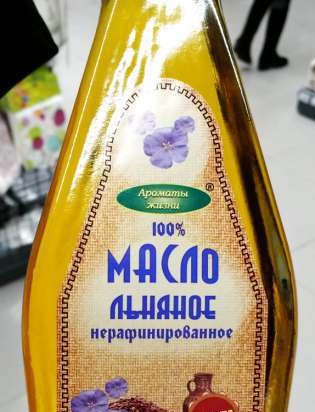


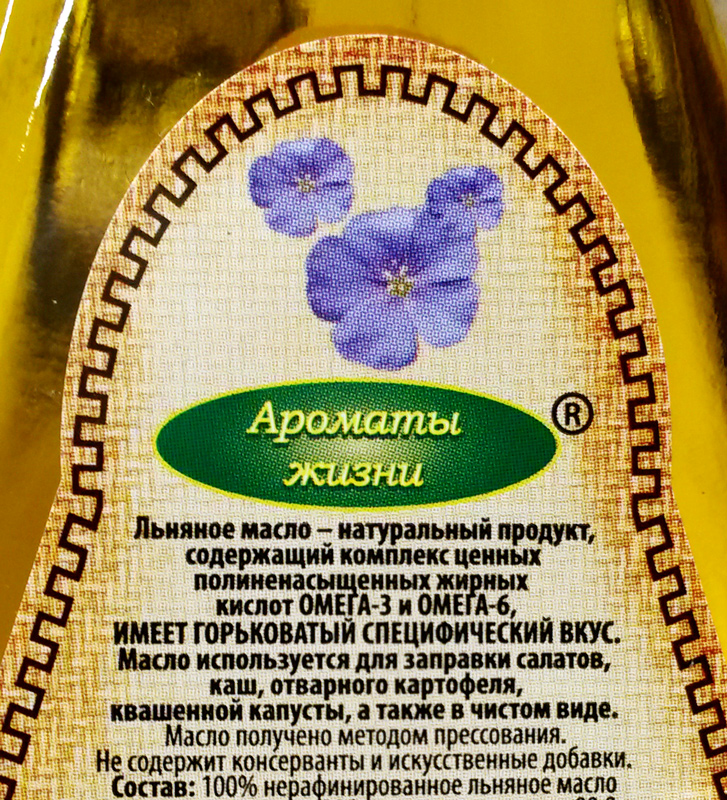
On which there is an inscription: "Has a bitter specific taste" (in my opinion, the more terrible flaxseed oil, I have not tried it all the time). Everything was fine, except that those who made linseed oil for themselves all wrote that there was no bitterness in the oil. Absolutely. Moreover, when I purchased
melanger and on it he himself made linen urbech, it also had neither taste nor aftertaste of bitterness. The bad bitterness: because it is an indicator of already rancid oil, which is more harmful than useful. Alpha-linolenic acid is also useful in that it has many double bonds, as a result of which it easily enters into a variety of reactions. And precisely because of this property, linseed oil, which, apparently, does not contain very many natural "preservatives", very easily goes rancid and becomes poisonous. For about a year I was trying to find good oil in retail. For example, I found butter on the VkusVill network, which was 2 weeks old, from the moment of production and bottling: the bitterness was obvious in the taste. And at that moment it was even more than that of the oil that I bought in the same store, about a month ago and which I had already managed to stand for 1 month in the refrigerator.
Also, I came across interesting information in the article Flax for human consumption: seed or oil ?:
🔗It is mentioned that in France the sale of flaxseed oil is prohibited, as it can easily deteriorate and become poisonous, and, personally, I come to the conclusion that this is correct.In general, as a result, this topic was important for me, I could not find the purchased linseed oil that would suit me, and for this reason I decided to buy a household oil press and slowly learn to make a product of the quality that I need using it. The first few attempts to squeeze out flaxseed oil were not very good: some bitter aftertaste was present, although noticeably less than in any purchased oil, but now I understood a little what's what and I get an oil that suits me completely. In addition to the absence of bitterness, homemade linseed oil has a slightly different taste than the purchased one, even the so-called "first cold pressed". Among other things, I plan to cook chocolate of my own recipe and for this I need cocoa butter.
As a result, I got what I wanted:
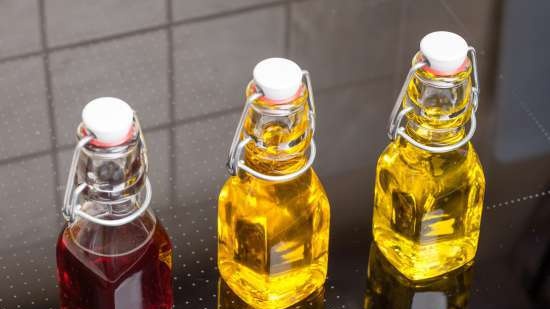
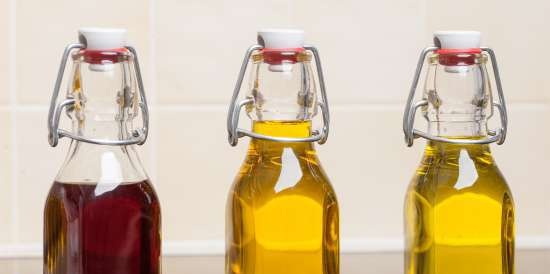
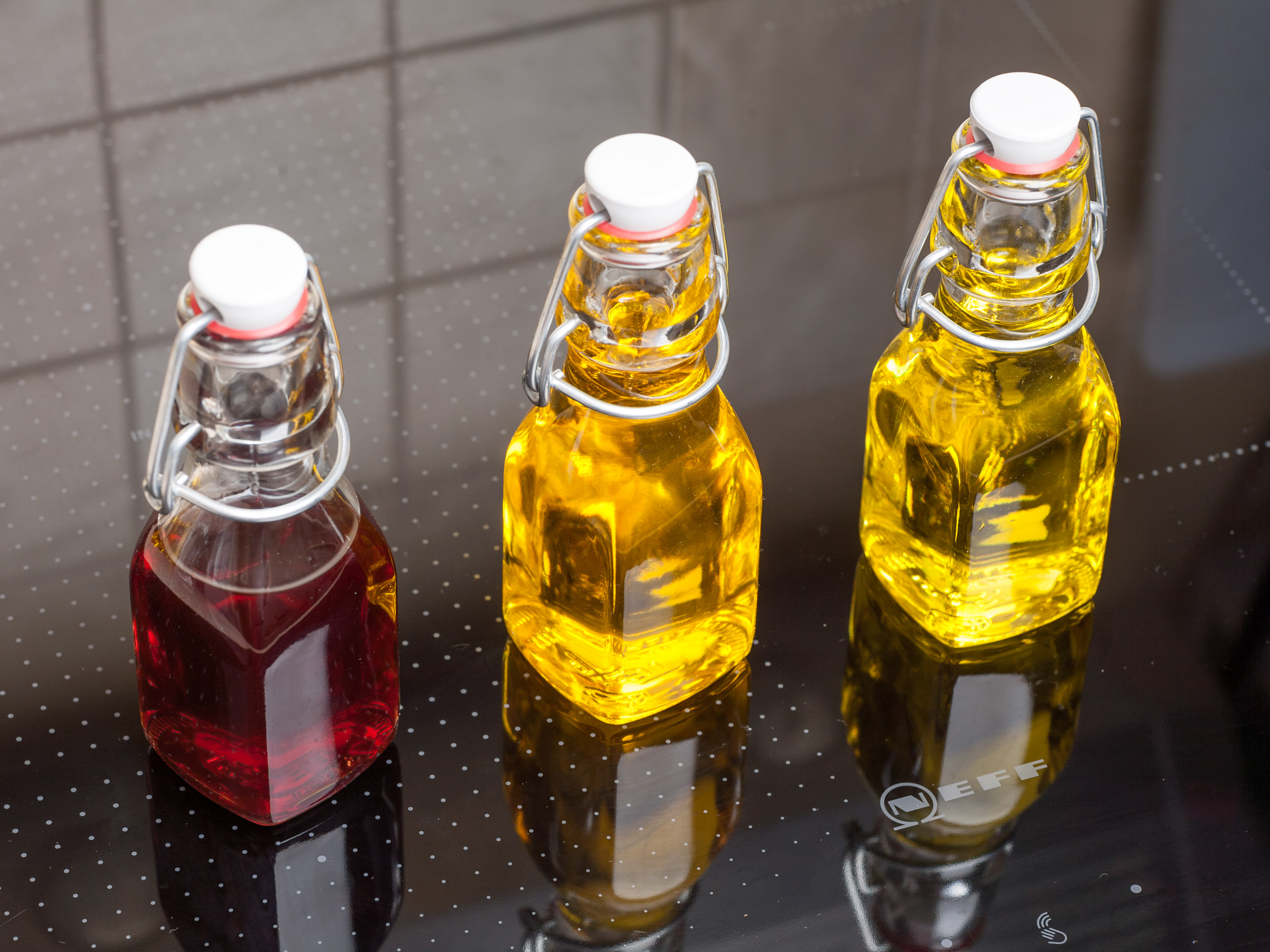
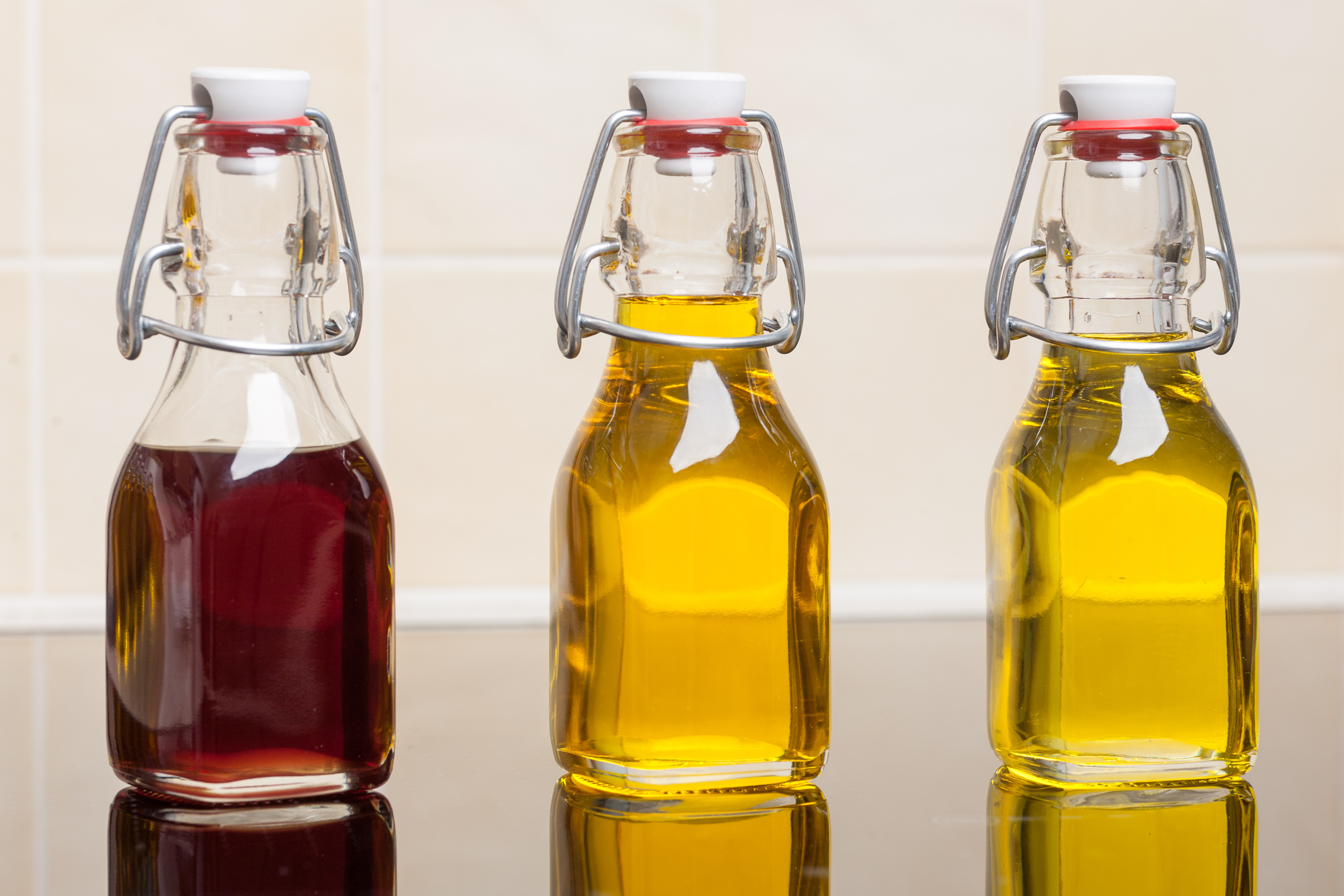
Oil squeezed and filtered at home, from left to right: from peeled pumpkin seeds, linseed, cedar
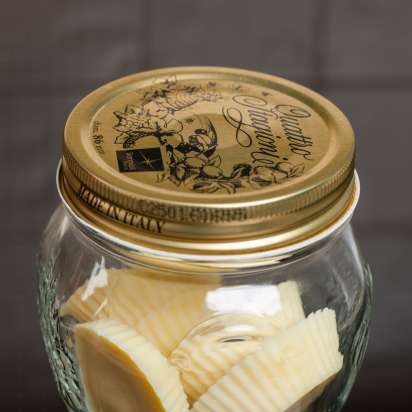
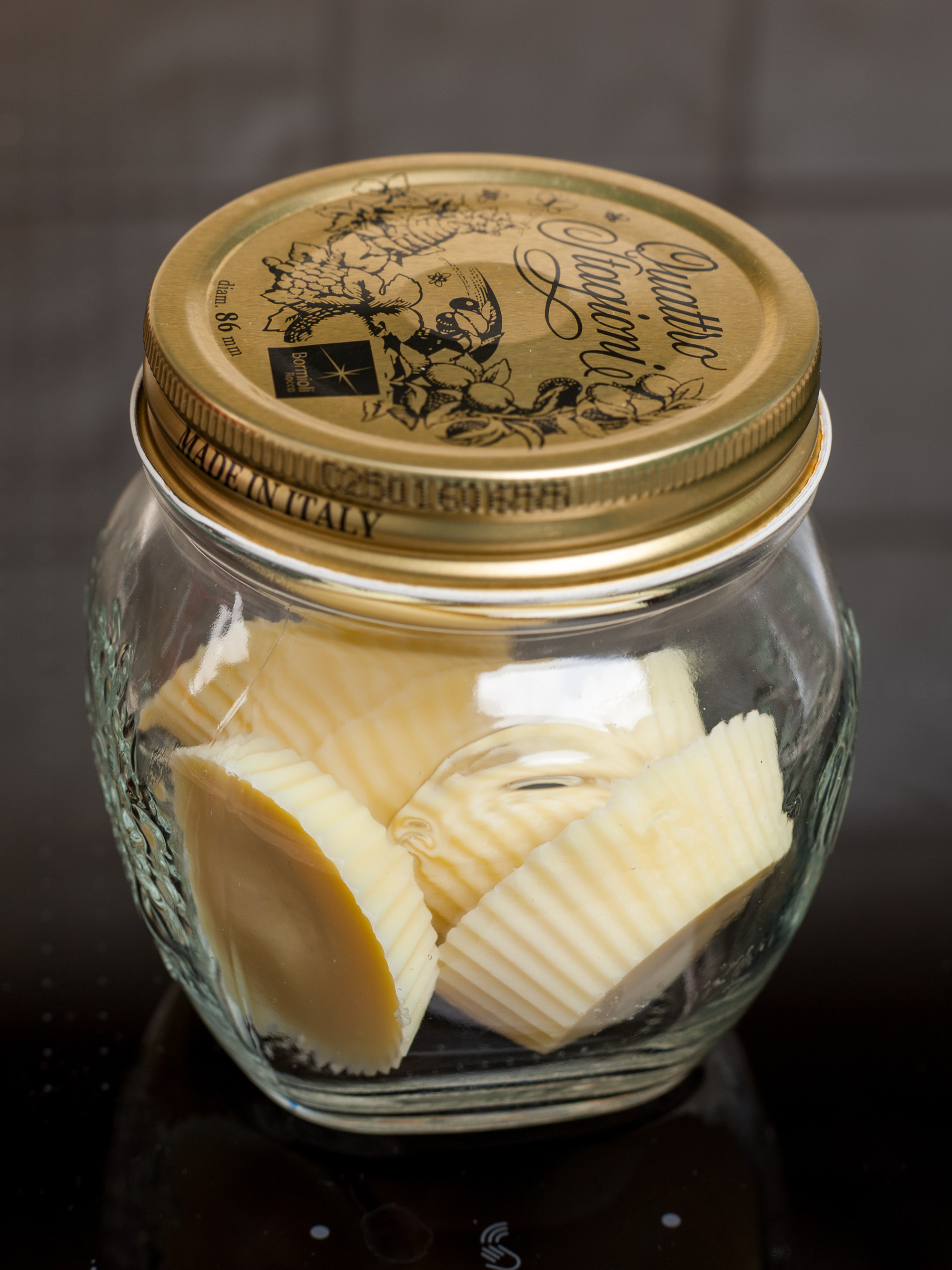
and cocoa butter.









